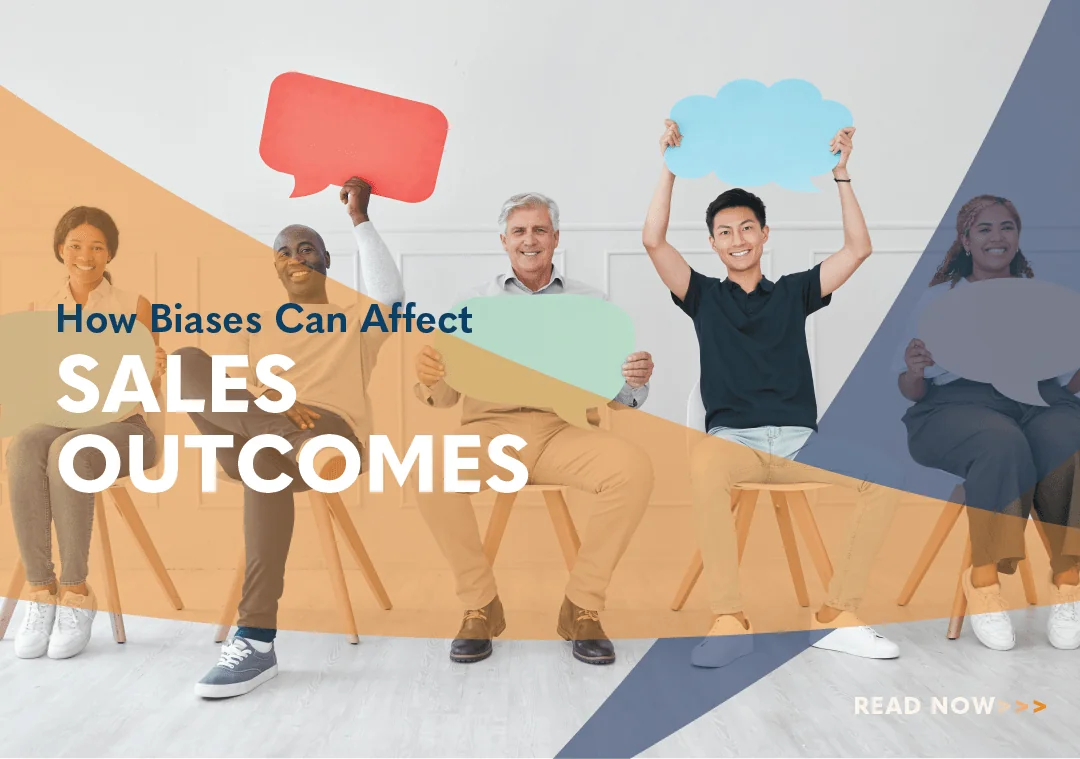How Biases Can Affect Sales Outcomes

A sales rep recently complained, “We had the better solution and price, and we still lost the sale.” These missed opportunities leave sales reps wondering if the prospect was even listening during the presentation. When prospects don’t listen it’s not their ears that are closed, but their subconscious mind. Unconscious bias is something everyone has. This article explores how sales reps can break the bias and the negative impact affecting their sales outcomes.
Humans are complicated creatures. The more we succeed, the more confidence we develop in our decisions. Yet, studies show there is a poor correlation between confidence and competence. The more successful a person is, the stronger their biases tend to be. For sales professionals selling to high-level decision makers, the question is how we handle unconscious biases that negatively impact our outcomes.
Losing a sale is often not the salesperson’s fault, but it is absolutely their responsibility to learn why the deal was not won. Before you blame the prospect, the product, or the price, it helps to understand how the brain operates and the unconscious biases that impact your sales efforts. When sales reps understand how the subconscious mind sabotages thinking, our best efforts can lead to more success.
What Is Cognitive Bias?
Cognitive bias is a thinking error with disproportionate weight in favor of or against an idea or thing. It’s a mental shortcut that everyone has, and it can be positive or negative. We develop our biases over a lifetime of experience from family, school, work, media, and institutions. As sales professionals, it’s unlikely we will be able to change someone’s bias, but we can reduce their effect by recognizing their impact. Let’s explore the significant bias impacting sales professionals.
Confidence Bias
In business, confidence is considered a strength. Decision makers in a position of power have a dominant identity, making it challenging to teach them new things. They also assume that other people think like they do, making it challenging to work with people below them on the learning curve. When a decision maker gets short with you on a call, their confidence bias is kicking in.
For example, when a sales rep has a discovery call with a decision maker and asks a generic open-ended question like, “What challenges are you facing?” this question triggers resistance because the decision maker’s confidence bias is activated. They do not feel it’s their job to teach sales reps what they believe they should already know.
To avoid activating the buyer’s confidence bias, sales reps can frame the question around industry-specific challenges and ask the decision maker which one is on their radar. For example, “We typically see companies your size are (struggling with, missing out, losing time) with (specific problem #1 or specific problem #2). What are you seeing on your end?”
So instead of triggering their confidence bias with generic open-ended questions, which in their buyer’s mind says, “This person doesn’t know anything about our industry or company,” sales reps can frame the question around specific problems. Specific problems allow the decision maker to get involved in creating the solution. When the decision maker becomes involved, they take ownership. Ownership is a good thing because it triggers the IKEA Bias.
IKEA Bias
IKEA is the world’s largest furniture brand and retailer that requires customers to assemble the products they purchase themselves. They figured out that we place a higher value on things we have a role in creating. We add value to projects we are personally involved with. Decision makers do the same thing during the buying process.
Sales reps can benefit from copying the IKEA concept. Instead of jumping into the solutions, allow the decision maker the opportunity to build it themselves. Building a solution takes work, and the extra work creates value. Average sales reps skip getting the buyer involved in creating the solution step, present a cookie-cutter presentation and ask, “So what do you think?” at the conclusion.
For example, a buyer will ask about a specific feature or capability during a presentation. The sales rep responds, “Oh yes, we can do that, no problem,” or “We already have that in development,” and skip right over the question. Most people don’t associate value with things that are “no problem.” Instead, the sales rep applies the IKEA bias, allowing the buyer to “unpack” the problem together, understand why it’s essential, and create a specific solution together.
Unpacking the problem is counterintuitive to what most sales reps want to do. We want to solve our client’s problems, but clients will place more value on solutions they feel involved with creating. This helps explain why the best solution only sometimes wins, regardless of the value of the solution.
Halo Bias
Halo bias is a perception distortion that affects how people perceive someone of whom they have a positive opinion from past experience. When a sales rep calls into a new account, the decision maker will apply the halo bias to their current salesperson or solution. For salespeople prospecting for new business, it’s essential to consider how the halo bias can influence how buyers judge you.
You can develop a narrow focus and deep expertise to counteract this bias and allow it to work for you. Think of it as building a moat around your ideas so that people won’t confuse you with someone else. For example, the buyer says, “We are happy with the CRM provider we already have.” The sales rep can respond, “Our solution may seem similar to CRMs, but they focus on customer lifecycle management, and we focus on lead lifecycle management.”
When sales reps can narrow their focus, they will be perceived as experts, which ironically creates more opportunities due to Halo Bias. Conversely, positioning oneself as similar dilutes your perceived expertise and reduces opportunities. If your prospect uses a competitor, they likely placed a mental halo around their salesperson and the solution. When sales reps narrow their focus, this allows the prospect an opportunity to establish a halo around the new and unique solution.
Recency Bias
Recency bias is a thinking error that allows recent events to impact our decisions more than they should. For example, if a sales rep loses a few deals in a row, they change their sales process, ignoring tested historical data. Recency bias is hard to resist in sales because if we’ve been unsuccessful a few times, it’s hard not to think it won’t happen again.
In the book Thinking Fast and Slow, Daniel Kahneman says, “We give too much weight to information we’ve seen, heard, read or experienced most recently.” For sales reps, this means if they can be the last vendor to present in the prospect’s buying cycle, they will be viewed as more valuable. If you are unfortunate to go first, it will help to add new information or update the presentation before the final decision.
Recency bias is a common source of disappointment in sales training. Companies approach sales training as something they need to do because of a lousy quarter. It’s a one-and-done effort to check the training box. Recency bias creates artificial confidence in the sales leaders and their reps. It’s like sending a person to a few days of self-defense classes and having them get in the ring with an experienced MMA fighter.
In Conclusion
In sales, the wrong approach is to try and manipulate a prospect and what they should think. The right approach is to help them make up their mind with clear thinking. You can only help prospects make up their mind by accounting for bias. Most attempts at changing a prospect’s mind create greater resistance because it forces the prospect to defend their position. Once people form their opinions, facts alone do not change behaviors.
If you want to win in sales or a political argument, accounting for cognitive bias will improve your outcomes. Remember, your prospect is not constantly reacting based on logic and facts, but deep-seated opinions, hunches, and gut feelings. These thinking errors influence the way they act toward salespeople. Just knowing about these biases is not enough to change a buyer’s mind. But once you accept biases exist, sales leaders are better prepared to figure out solutions. For sales reps, their best bias is for unrelenting learning and making the next best decision with all data available.
You don’t need to pretend you have all the answers. But you do need to demonstrate you have the capacity to find them and to pivot when the moment comes.

- Account Planning (11)
- Awards (50)
- Client Testimonial (37)
- Personal Branding (19)
- Podcast (11)
- Research (68)
- Sales Career Development (85)
- Sales Coaching (153)
- Sales Consulting (133)
- Sales Culture (164)
- Sales Enablement (340)
- Sales Leadership (108)
- Sales Management (242)
- Sales Negotiation (16)
- Sales Prospecting (124)
- Sales Role-Playing (18)
- Sales Training (229)
- Selling Strategies (255)
- Soft Skills (67)
- Talent Management (92)
- Trusted Advisor (27)
- Virtual Selling (41)
- Webinar (10)





























